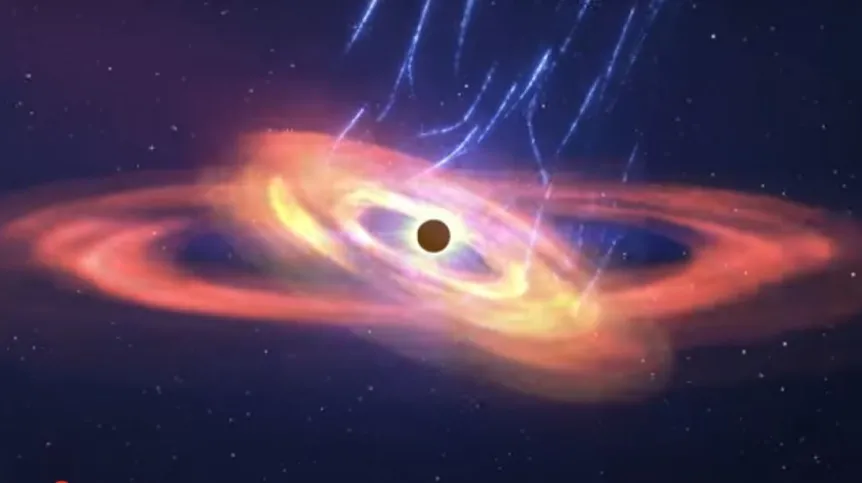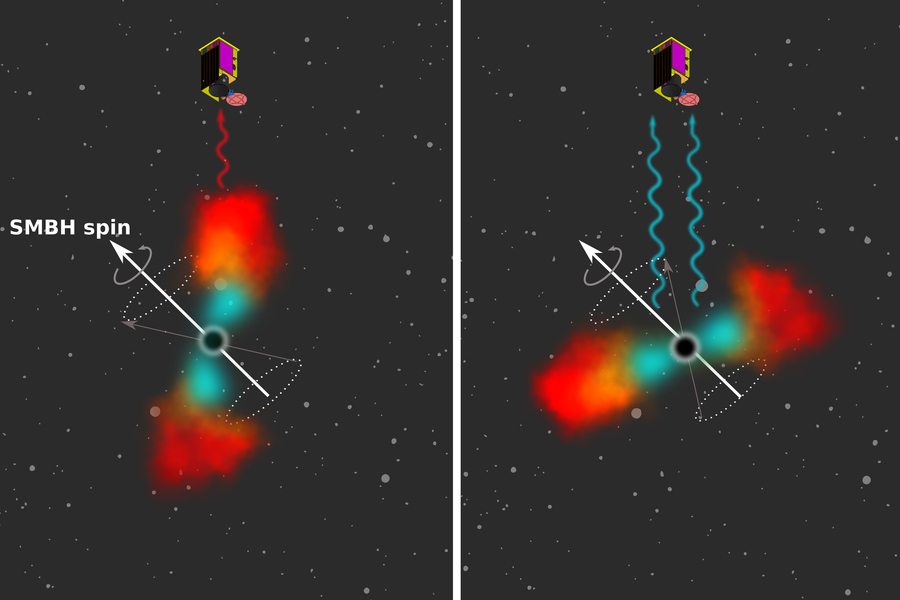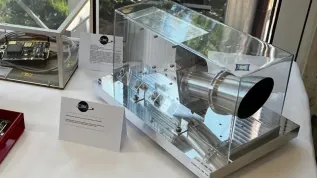
Astronomers have measured the rotation speed of a supermassive black hole for the first time by observing 'wobbly' stellar matter.
The team has developed a new way to measure the rotation speed of a black hole using 'wobbling' remnants of stellar material.
Professors Bożena Czerny and Agnieszka Janiuk from the Center for Theoretical Physics of the Polish Academy of Sciences took part in the groundbreaking study described in Nature. The leader of the international team was Dr. Dheeraj 'DJ' Pasham of MIT. The research results are summarized in the MIT and the Center for Theoretical Physics PAS press releases.
Every black hole rotates at a certain speed, and this speed can be linked to certain processes in its history. A high rotation speed of the black hole is related, for example, to the fact that in the past the black hole gained mass as a result of accretion - short moments in which a certain amount of material fell into the hole. In turn, slower rotations may indicate that the black hole was created, for example, as a result of the merger of a pair of black holes.
As a black hole rotates, it drags the space-time surrounding it. Typically, this effect would not be obvious for black holes because these massive objects do not emit light. However, light appears near the black hole, for example during the so-called tidal disruption event (TDE).
If a star gets too close to a black hole, there are significant differences in the gravitational force acting on different parts of this celestial body. The so-called tidal force (it may be compared to the ebb and flow of the sea) tears the star into pieces, and this is accompanied by the emission of light. Some of the star's material is scattered into space, while the other part forms a hot accretion disk of rotating stellar material around the black hole.

Scientists predict that during a tidal disruption, a star could fall into the black hole from any direction, generating a disk of white-hot, fragmented material that could be tilted or move against the direction of the black hole's rotation. (You can imagine the accretion disk as a tilted torus rotating around a central hole that has its own distinct spin). The rotating black hole affects the rotating disk, pulling it into alignment and causing the disk to wobble. Eventually, this wobbling stops as the disk settles into the black hole’s spin. Scientists predicted that a TDE’s wobbling disk should therefore be a measurable signature of the black hole’s spin.
The authors of the new paper proposed that in cases such as a tidal disruption event, it would be possible to track the light from stellar debris as it is dragged around. And the wobble of the newly formed accretion disk would be the key to determining the natural rotation of the central black hole. This gives hope of measuring the rotation speed of black holes and better understand the history of these interesting objects.
'In a study appearing today in Nature, the astronomers report that they have measured the spin of a nearby supermassive black hole by tracking the pattern of X-ray flashes that the black hole produced immediately following a tidal disruption event. The team followed the flashes over several months and determined that they were likely a signal of a bright-hot accretion disk that wobbled back and forth as it was pushed and pulled by the black hole's own spin. By tracking how the disk's wobble changed over time, the scientists could work out how much the disk was being affected by the black hole's spin, and in turn, how fast the black hole itself was spinning. Their analysis showed that the black hole was spinning at less than 25 percent of the speed of light.
Professor Agnieszka Janiuk and Professor Bożena Czerny collaborated to analyse competing models for explaining the phenomenon. 'My contribution consisted in providing the GLADIS computer code, of which I am the author, used to model the global thermal instabilities of the accretion disk', Janiuk says. These models proved less satisfactory when confronted with the data, thus confirming the main result.
Dr. Pasham hopes that the new method can be used to measure the rotation of hundreds of black holes. This would help understand how they evolved in the history of the Universe.
'The key was to have the right observations', says Dr. Pasham. 'The only way you can do this is, as soon as a tidal disruption event goes off, you need to get a telescope to look at this object continuously, for a very long time, so you can probe all kinds of timescales, from minutes to months'.
For the past five years, Dr. Pasham has been searching for tidal burst phenomena that are bright enough and near enough to be able to react quickly enough and observe them, trying to find signs of Lense-Thirring precession. In February of 2020, he and his colleagues got lucky and detected AT2020ocn, a bright flash, emanating from a galaxy about a billion light years away. From the optical data, the flash appeared to be the first moments following a TDE. 'We needed quick and high-cadence data', says Dr. Pasham. ‘The key was to catch this early on because this precession, or wobble, should only be present early on. Any later, and the disk would not wobble anymore'.
NASA's NICER X-ray telescope was able to catch the TDE and continuously observe it over months at a time. Dr. Pasham and his colleagues analysed NICER's observations of AT2020ocn over 200 days following the initial detection of the tidal disruption event. They discovered that the event emitted X-rays that appeared to peak every 15 days, for several cycles, before eventually petering out. They interpreted the peaks as times when the TDE’s accretion disk wobbled, emitting X-rays directly toward NICER telescope, before wobbling away as it continued to emit X-rays (similar to waving a flashlight toward and away from someone every 15 days).
Based on estimates of the black hole's mass, and the mass of the disrupted star, the researchers were able to estimate the black hole's spin.
This is the first time that scientists have used observations of a wobbling disk following a tidal disruption event to estimate the spin of a black hole. Dr. Pasham predicts that there will be more opportunities to determine black hole spins as new telescopes such as the Rubin Observatory come online.
The research projects was co-financed by NASA and the European Space Agency. (PAP)
PAP - Science in Poland, Ludwika Tomala
lt/ zan/ kap/
tr. RL













